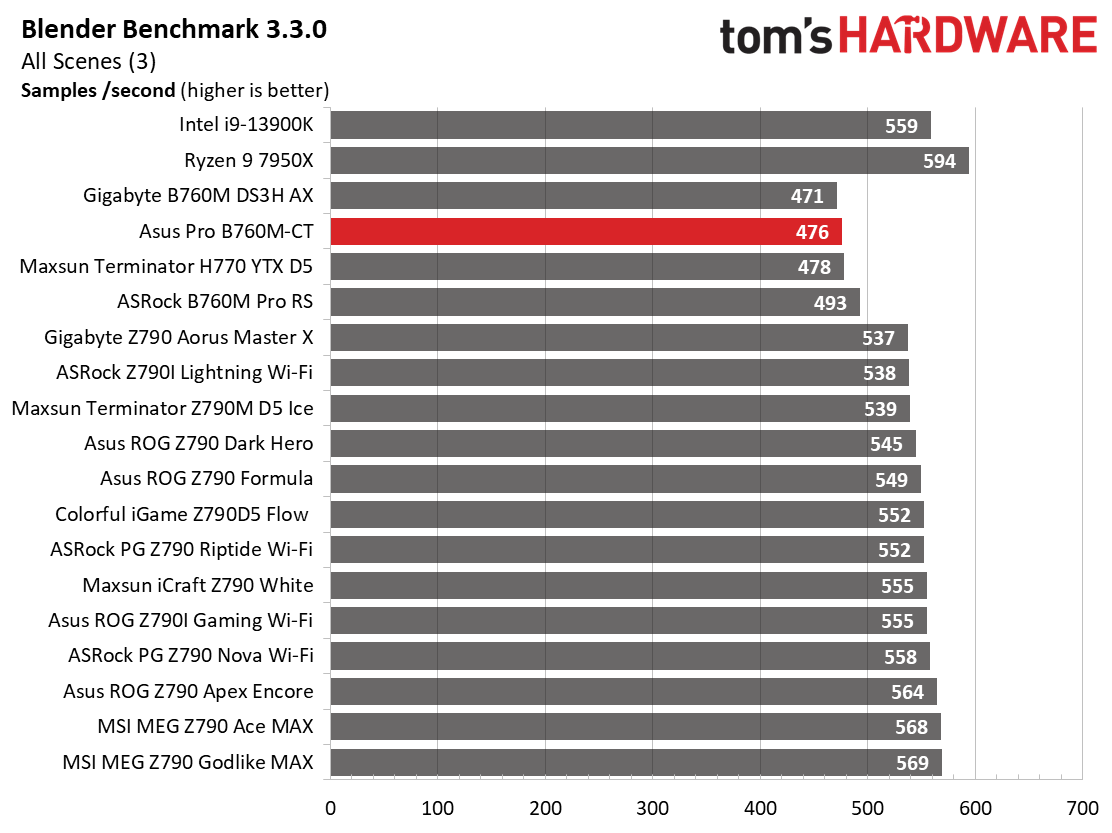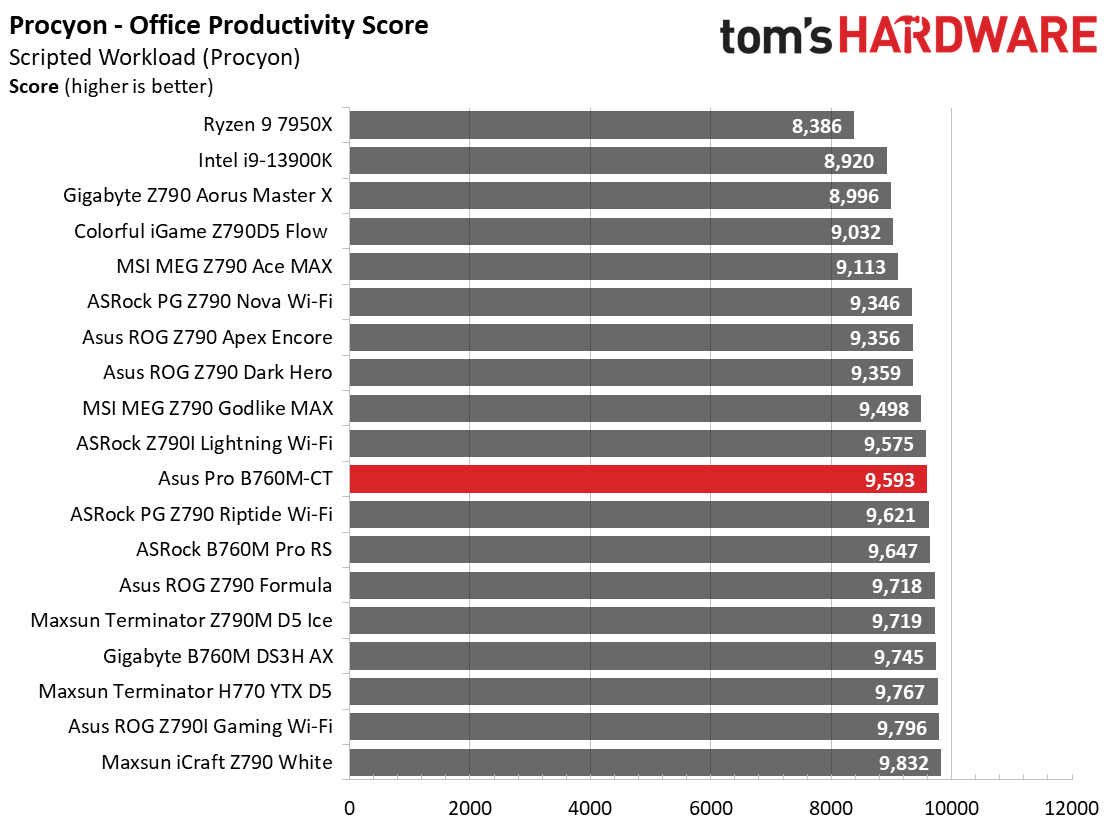Why you can trust Tom's Hardware
Our standard benchmarks and power tests are performed using the CPU’s stock frequencies (including any default boost/turbo) with all power-saving features enabled. We set optimized defaults in the BIOS and the memory by enabling the XMP profile. For this baseline testing, the Windows power scheme is set to Balanced (default) so the PC idles appropriately.
Synthetic Benchmarks
Synthetics provide a great way to determine how a board runs, as identical settings should produce similar performance results. Turbo boost wattage and advanced memory timings are places where motherboard makers can still optimize for stability or performance, though, and those settings can impact some testing.


















Performance across the synthetic portion of our benchmarks was largely below average, again due to the default power limits. This board peaks around 190W, then drops to 125W. Since our processor’s default TDP for boost is 253W, you’re never really getting the most out of high-powered processors on boards like this. Applications like POV-Ray and Cinebench take hits in the multi-threaded test but match up with other, less restrictive boards in the single-threaded.
Procyon Office, one of the more relevant tests for this type of motherboard, showed good results overall. So long as you aren’t beating on the board with a flagship-class processor and long-running heavily threaded applications, performance is where it should be for the CPU.
Timed Applications




The timed applications show similarly poor results. LAME times were slightly slower than average, while Corona's results matched the slowest we’ve recorded. Handbrake results were the second slowest so far, another sign of how limited it is with a high-powered CPU in longer-running, heavily threaded testing. Note that these B760M/H770 boards we’ve covered all tend to perform below where most Z790-based options place.
3D Games and 3DMark




Starting with the launch of Zen 4, we shifted our test games from F1 21 to F1 22 while keeping Far Cry 6. We run the games at 1920x1080 resolution using the Ultra preset (details listed above). As the resolution goes up, the CPU tends to have less impact. The goal with these settings is to determine if there are differences in performance at the most commonly used (and CPU/system bound) resolution with settings most people use or strive for (Ultra). We expect the difference between boards in these tests to be minor, with most falling within the margin of error differences. We’ve also added a minimum FPS value, which can affect your gameplay and immersion experience.
Game testing showed promise, with the B760M-CT performing very well in our two games, nearly leading the pack. 3DMark testing was slower than the rest, partly due to the CPU test. Still, it’s a more than capable gaming board should there be some after-hours fun in the office or at home.
Get Tom's Hardware's best news and in-depth reviews, straight to your inbox.
Overclocking
Generation after generation, overclocking headroom has been shrinking with both Intel and AMD processors, with motherboard partners pushing the limits to set themselves apart from the plethora of options available to the consumer. With the overclocking headroom gone, we’ve left things at stock for cores but will push the Integrated Memory Controller (IMC) for faster RAM. Remember, for 14th-gen CPUs, the maximum stock spec for memory is DDR5-5600. We have a DDR5-7200 kit and a DDR5-8000 kit in-house to test the higher speeds.
Chances are nobody is trying to overclock memory on this board, but if you are, it doesn’t support ultra-fast memory but does go above the maximum base spec. Asus lists the maximum as DDR5-6200(OC). As expected, our DDR5-6000 kit worked without issue, and we did not try to push past that. Again, this board is made for business and stability, not overclocking and squeezing out extra MHz.
Power Consumption / VRM Temperatures
We used AIDA64’s System Stability Test with Stress CPU, FPU, Cache, and Memory enabled for power testing, using the peak power consumption value. The wattage reading is from the wall via a Kill-A-Watt meter to capture the entire PC (minus the monitor). The only variable that changes is the motherboard; all other parts remain the same. Please note we moved to using only the stock power use/VRM temperature charts. Since the system uses every available degree Celsius, unless you’re using a sub-ambient cooling solution, you’ll use more power and generate more heat using default settings.
Power use on the B760M-CT was good overall, as expected, with the power limits in place. At idle, the board hovered around 45W—one of the lower values we’ve recorded on this platform. During a stress test, power use peaked at 350W at the wall, then dropped to around 275W after the CPU returned to the base 125W TDP.


VRM temperatures peaked at almost 80 degrees Celsius during our stress tests, which is on the hot side. But this makes sense, considering the only thing cooling the ‘old school’ VRMs is airflow (there are no heatsinks). That said, I wouldn’t want to raise any of the power limits or boost durations, as the power delivery will get too hot and throttle or potentially damage the board when using high-power processors. Processors with a lower TDP will be fine if you want to push those limits.
Bottom Line
We haven’t covered business-class motherboards in recent years so this was, in some ways, a breath of fresh air. Performance-wise, there’s little difference among boards like this that tend to follow Intel’s power limits. On the other hand, Z790-based boards tend to be all over the place with power limits, some even running unlimited, letting cooling be your ultimate stopping point. But if you’re an IT professional in charge of desktops, the goal is to provide a stable, performant environment for your users as well as a manageable environment for IT. And the Asus Pro B760M-CT CSM does that.
You get all the basics for an office PC and more for $139.99 (less on sale or with a volume discount). The B760M-CT CSM supports 12th-14th generation processors, has enough storage options for office use, can output to four monitors from the integrated GPU, and has a slew of IT management features like the CSM program and the Asus Control Center Express software (among others) to help monitor your ecosystem. Performance was solid in lightly threaded applications but does choke when using high-power processors and heavily threaded programs. But drop in a CPU with a lower TDP, and you should be able to get everything out of it.
We’re not going to compare this board to the other recent Micro ATX boards we’ve tested, as this one is meant for the office rather than your home. From a hardware standpoint, it certainly does the job. Asus also supports IT Managers with software and security features designed to make managing the environment easier. For a basic motherboard designed for long-term stable operations, the Pro B760M-CT CSM is a viable option. Can you buy this for general use? Surely. But there are boards like the Gigabyte’s B760M DS3H AX and the ASRock B760M Pro RS we covered that work just as well, have a few more ports and features, and also looks better in a windowed chassis. Which option is best for you depends on how you will use the machine.
MORE: Best Motherboards
MORE: How To Choose A Motherboard
MORE: All Motherboard Content

Joe Shields is a staff writer at Tom’s Hardware. He reviews motherboards and PC components.
-
dimar I buy these Asus Pro business motherboards religiously for office builds for many years and have close to 0 issues.Reply


